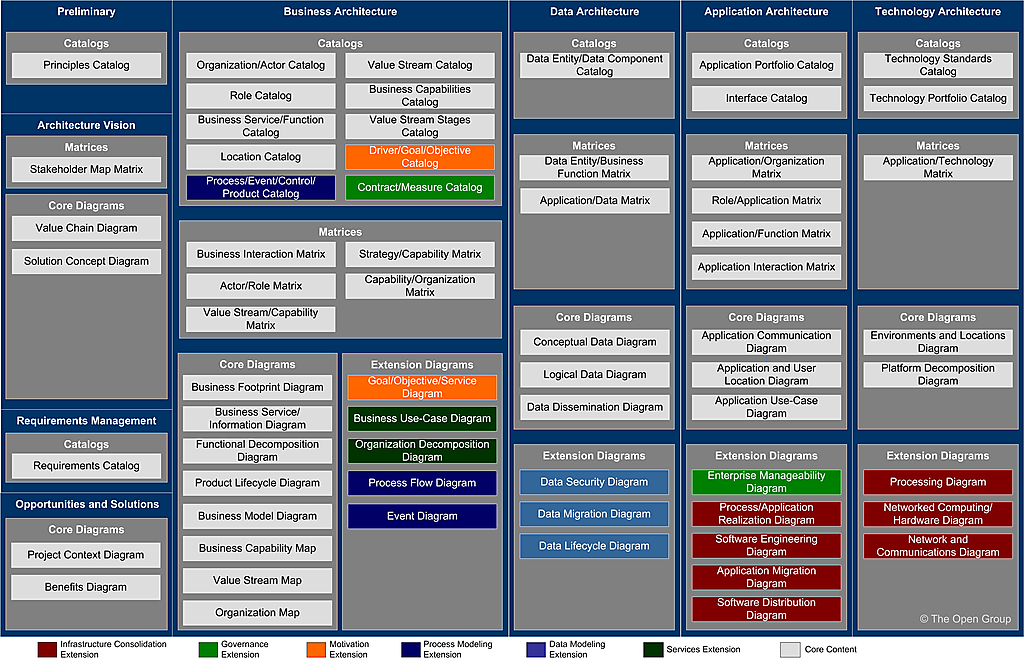Introduction
In the complex world of enterprise architecture, where strategies, technologies, and visions intertwine, The Open Group Architecture Framework (TOGAF) Architecture Development Method (ADM) stands as a beacon. Central to its effectiveness are the architectural artifacts, the unsung heroes orchestrating the grand narrative of enterprise evolution. This article delves into the intricacies of TOGAF ADM and its dance with building blocks, catalogs, matrices, and diagrams, weaving a tale of structured communication, organizational prowess, and stakeholder enlightenment.
Artifacts in TOGAF ADM
TOGAF ADM and architectural artifacts are like the dynamic duo of enterprise architecture. The ADM phases are like the stages in a play, each with its own set, characters, and plot twists.
Let’s break it down:

Preliminary Phase:
Artifact Emphasis: Not explicitly mentioned in the supplied text, but this phase sets the stage for the entire process, defining scope, principles, and readiness. It may involve initial versions of catalogs or diagrams to capture high-level concepts.
Phase A – Architecture Vision:
Artifact Focus: The architecture vision is crafted here, often through diagrams to depict high-level concepts and goals. These might be visual representations to help stakeholders envision the future state.
Phase B – Business Architecture:
Artifact Highlights: Building blocks take the spotlight here, representing fundamental business entities. Catalogs could include business service catalogs, showcasing essential services. Diagrams may include business process flow charts.
Phase C – Information Systems Architectures:
Artifact Center: Building blocks continue, now emphasizing the information systems perspective. Catalogs might delve into data entities and application services. Diagrams may include system communication diagrams.
Phase D – Technology Architecture:
Artifact Spotlight: Catalogs become crucial, listing technology components and standards. Diagrams may include network topologies and technology stack illustrations. The focus is on ensuring technological coherence.
Phase E – Opportunities & Solutions:
Artifact Emphasis: Matrices become valuable here, especially when assessing different solution options. These might include matrices showing the relationships between business goals and technology options.
Phase F – Migration Planning:
Artifact Focus: Diagrams play a significant role in visualizing migration plans. These could include timelines, showing how components and systems evolve over time.
Phase G – Implementation Governance:
Artifact Highlights: Matrices are crucial during implementation governance, showcasing dependencies, compliance, and performance metrics. Diagrams may illustrate governance structures.
Phase H – Architecture Change Management:
Artifact Center: Building blocks and catalogs remain important, capturing changes and updates to the architecture. Diagrams may depict impact assessments and change propagation.
Phase I – Requirements Management:
Artifact Spotlight: Requirements often translate into building blocks and catalogs, ensuring that stakeholder needs are clearly documented. Diagrams may be used to visualize requirement dependencies.
Phase J – Architecture Partitioning:
Artifact Emphasis: Matrices help in partitioning complex architectures, illustrating how different components or systems interact. Diagrams may show the partitioned architecture from various perspectives.
Phase K – Architecture Repository:
Artifact Focus: This phase involves maintaining and populating the architecture repository, ensuring that catalogs, matrices, and diagrams are continually updated and aligned with the evolving architecture.
In the grand finale, the conclusion emphasizes the importance of these artifacts throughout the ADM. It’s like a well-orchestrated symphony where each instrument (artifact) plays its part to create a harmonious enterprise architecture. The key takeaway is that understanding which artifact to use at each phase is akin to having the right tools in a craftsman’s workshop—it ensures a masterpiece at the end.